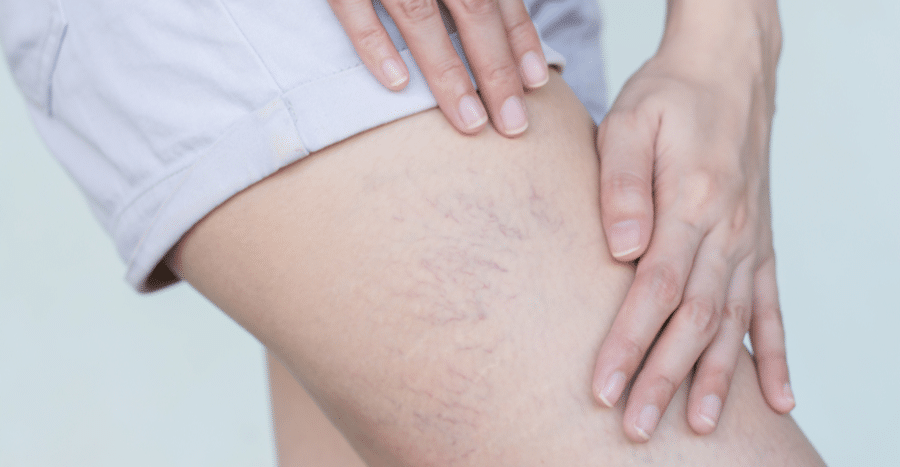Unsightly veins can make you hide your legs and possibly keep you from engaging in some of your favorite activities. Luckily, there are many treatment options available to help clear up signs of venous disease and allow your naturally clear skin to shine through. But, how do you know if you are a good candidate for Vein Treatment? Keep reading to learn more about venous disorders and the treatments available at the Venus Vein Treatment Clinic in Omaha, Nebraska.
What Is Venous Disease?
Venous disease covers a broad range of disorders involving the vascular system. Veins work to carry blood back to the heart to be re-oxygenated. Veins generally operate under much less pressure than arteries and have relatively thin walls designed to accommodate this.
Valves within veins allow blood to flow in a single direction. However, with time and stressful conditions, vein walls can weaken, causing valves to become less effective. Blood can pool in or flow backward through veins. When this happens, you may develop a venous disorder. Here are some of the most common disorders that are treated at the Venus Vein Clinic:
Spider Veins
The smallest and most common of vein disorders, spider veins are generally small and red or blue in appearance. They usually have a web-like pattern that spreads out over an area of skin. Spider veins are most commonly seen in the legs but may also appear on your face. Because of their superficial locations, most cases of spider veins are cosmetic. However, they may cause discomfort or serve as a warning of more serious venous disorders.
Varicose Veins
These are larger veins that are also visible through the skin. Varicose veins often have a bulging, twisted, or knotty appearance, and generally look blue, purple, or green. Like spider veins, they are most common in the legs but can also appear in other areas.
While many people consider varicose veins to be cosmetic, they can also cause pain and discomfort. Some people report heaviness in the affected area and itching on the skin around and over varicose veins.
Reticular Veins
Reticular veins fall between spider and varicose veins in size. They may appear thicker, like varicose veins, but are generally not as prominent. In some cases, reticular veins supply blood to smaller spider veins nearby. In these cases, they are called feeder veins.
Treatment Services Available
There are many treatment options for people suffering from venous disorders like varicose or spider veins. Most of them are minimally invasive, and they often require little to no downtime from normal activities.
Radiofrequency Ablation
Radiofrequency ablation is a minimally invasive treatment option. It involves a tiny catheter being inserted into your vein through a small incision. Heat is then applied to the inside of your veins. This stimulates the veins to produce collagen, which seals off and destroys the tissue. Once the vein is no longer functioning, it is dissolved and absorbed naturally by your body.
Radiofrequency ablation is considered a very safe and effective treatment option for varicose veins. It requires only limited downtime from normal activities. You may see results after a single session, although your individual circumstances will determine how many treatments are needed.
Venaseal Ablation
This revolutionary vein treatment uses a medical-grade adhesive to seal off affected veins. The adhesive is delivered to your vein with a small catheter, which is inserted through a tiny incision in your thigh. The adhesive seals off the affected vein, which is eventually absorbed or expelled by your body. Blood flow is naturally diverted to other, healthier tissue.
Venaseal is an ideal treatment option for busy people. It requires virtually no downtime, and in some cases, you can return to your regular activities immediately. You may not even need to use compression stockings in the days following treatment.
Sclerotherapy
This is a tried-and-true treatment for spider veins. Sclerotherapy is the least invasive vein treatment offered at Venus Vein Clinic. During your treatment, a salt solution is injected into your affected veins. This causes irritation and swelling of the tissue, which shuts down the flow of blood. As your blood flow is redirected to healthy tissue, the affected veins are processed by your body. The result is clearer skin without the appearance of spider veins. Treatments will generally take between 15 and 30 minutes, depending on your particular situation.
Ambulatory Phlebectomy
Another treatment option for varicose veins is an ambulatory phlebectomy. This involves a doctor making small incisions near the affected veins. They are then teased through the openings and removed from the body. Blood flow in the area is naturally redirected to other veins to help restore optimal circulation.
Because the affected veins are removed during the treatment, there is no need to wait for them to close off or be processed by your body. However, each individual is unique, and complete care instructions will be provided after your vein treatment.
Who Is a Good Candidate for Vein Treatment?
If you are living with varicose or spider veins, then you could be a good candidate for having them corrected. The right Vein Treatment Clinic option for you will depend on the severity of your condition, the size of the area affected, and your medical history. Some treatments, like sclerotherapy, work best on smaller spider veins. Others, like an ambulatory phlebectomy, are better suited to larger varicose veins.
Learn More Today
If you ready to find out which treatment option is right for you, contact the Venus Vein Clinic in Omaha, NE to schedule a consultation!

